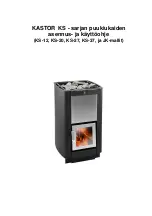
9
Wood type
Heat value
(kWh/kg)
maple, elm, willow
4.1
poplar, beech
4.2
oak, ash
4.2
birch
4.3
pine, fir
4.4
Permitted Fuels
Only natural, air-dried firewood may be burned. Under no circumstances should rubbish, other
fuels, and treated or damp wood be burned.
NEVER BURN IMPREGNATED OR PAINTED WOOD, LAMINATED PLASTIC,
PLYWOOD, CHIPBOARD, GARBAGE, FLAMMABLE FLUIDS SUCH AS
GASOLINE, NAPHTHA, ENGINE OIL, REFUSE, MILK CARTONS, OR
PRINTED MATTER. USE OF SUCH MATERIALS WILL INVALIDATE YOUR
WARRANTY, AS THIS MAY EMIT TOXIC, CORROSIVE AND HAZARDOUS
FUMES WHEN BURNED. THEY MAY ALSO CAUSE A BUILD-UP OF THE
TOXIC GAS DIOXIN, WHICH IS DAMAGING TO THE STOVE AND THE
ENVIRONMENT.
We recommend that firewood with less than 20 % moisture
content be burned. Wood is an environmentally friendly and
widely available solid fuel. To ensure that the wood has a mois-
ture content of 20 % or less, store it under a roof or protected
against heavy rain for a year or two. Use of wood with greater
moisture content can cause soot and creosote in the pipe and
chimney. This can lead to chimney fires.
Combustion involves conversion of the fuel from solid form
into gases, water vapor, and charcoal. The heating value is an
expression of the content of combustible gases. All wood has
roughly the same heating value per kilogram. The lighter the
wood, the more that must be used to achieve the same heat
value as the heavier species of wood.
Thus, preferred wood
types in New Zealand are softwoods.
Initial Use
BEFORE STARTING UP THE STOVE, MAKE SURE TO REMOVE THE
PACKAGING MATERIAL.
Although the Twinfire is carefully cleaned and inspected several times, remainders of the sand
blasting or shavings of the Vermiculite plates in the fireplace can stay. We suggest before use
that you vacuum and wipe clean all surfaces with a soft, dry cloth to avoid baking on film or dust
particles. Please note also that the stove paint will harden during the first few initial fires. This
means that the stove may generate some smoke and an odor of paint, which will dissipate after
about an hour’s operation. It is a good idea to insure effective ventilation during this phase. Also,
avoid touching the stove during the curing process.



































